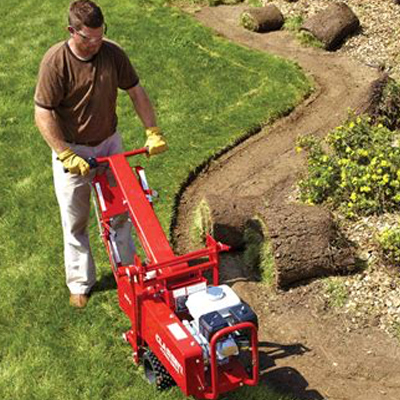How to Reduce Lawns
Now we have explained the importance of reducing lawns, here are the actual measurements you can take to remove turf. Which method is best for you, depends on your means, the size of the lawn and the location.

Manual removal

Sod Cutter

Sheet mulching

Herbicides

Solarize

Burning
Mechanically Removing
The most common way to remove a lawn is to physically remove the sod by cutting it into strips with a spade or a sod cutter, rolling the strips up, and either taking them away or turning them over and letting them compost in place. The cut sod can be laid upside down in the middle of the area being removed, to create a mound, as fill in a low spot or to create a berm if needed elsewhere in the garden. Whether moving to a new spot, or composting in place, cover with a layer of newspaper (6-10 sheets thick, and overlapping) and 4-6 inches of compost, and lastly with 3-4 inches of mulch to decompose, create good soil, and prevent grass re-growing. (Note that if you leave the sod in place, or mound it, you’re turning a quick method into a slower one.)
Removing sod doesn’t work if you have a persistent perennial lawn grass like Bermuda grass. Simply removing the sod on Bermuda guarantees that it will be back, since the roots go down for several feet, and it only takes an inch of root to grow it all back. In this case, the only way to get rid of the lawn is through solarization (or herbicides)—plus several months of waiting to be sure it’s really gone.
Sheet Composting
Cut the grass as short as possible. Cover the entire area with cardboard (either used boxes or purchased rolls) or newspaper (10-12 layers). Make sure that the edges overlap a goodly amount and no sunlight gets through the paper. Water paper, cover with a layer of compost, then mulch at least 4 inches thick. You can scatter grass and/or wildflower seeds in the compost if you’re looking for a ‘meadow’ (before you apply the mulch). You can also cut holes in the paper to plant individual plants, or wait until the paper has decomposed and dig planting holes for your new plants. This method adds organic matter to soil, requires minimal labor, and does not require removal and disposal of turf. It also takes a fairly long time, and is not practical on steep slopes.
Herbicides
Some landscapers use herbicides to save money and time. But we advise you, if possible, to avoid these chemicals and use a more eco-friendly method, like sheet mulching.
Solarizing
Technically, solarization is a method of soil sterilization using clear plastic, but a version, which might be called ‘light exclusion’ using black plastic, works for lawn removal. This method works best in areas with high summer temperatures, and should be done as spring is turning to summer. Cut the grass as short as possible and water well. Cover with large rolls of sturdy black polyethylene held in place by rocks or metal stakes. Cover the area, making sure it is airtight with no holes. The plastic sheets allow the sun’s radiant energy to be trapped in the soil, heating the top 12 to 18 inches. When properly done, the top 6 inches of the soil will heat up to as high as 140°F, depending on the location. Leave in place for about 4–8 weeks—depending on how hot the weather is–until grass is dead. The high temperature may also kill some insects, plant diseases, nematodes and soil pathogens in the top layer of soil. Remove the plastic, and leave the dead grass to compost in place. This method also requires minimal labor and has minimal environmental impact. However, it takes a fair amount of time, must be done in hot weather and is unsightly.
Burning
On some occasions burning can be the quickest way to remove turf. But it is very dangerous and can only be done with legal permission.
